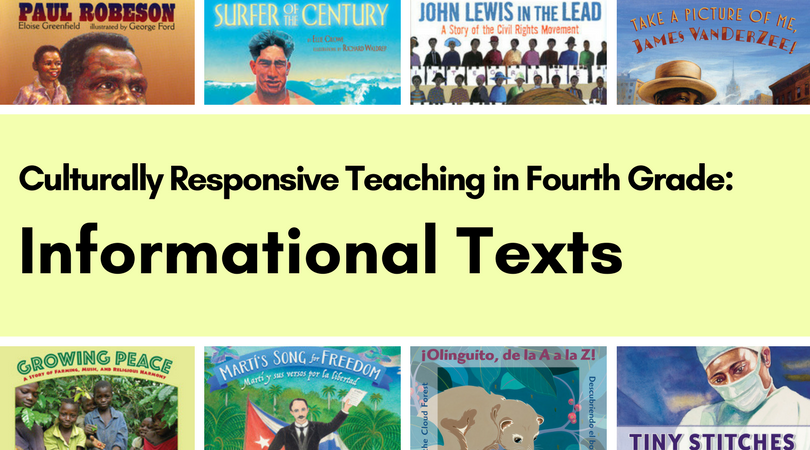
In this ongoing series, we explore what culturally responsive teaching looks like at different grade levels and offer concrete examples and resources. Last month we explored culturally responsive teaching around Valentine’s Day. This month, educator Lindsay Barrett offers guidance for a culturally responsive study of informational text at the fourth grade level.
Selecting diverse stories and setting up related discussions are important and logical aspects of ensuring that your classroom is a culturally responsive one. Stories have the power to draw students in, inspire them, make them feel seen and heard, and stretch the boundaries of their thinking.
Don’t forget about informational text, though! It’s certainly gotten its share of attention in recent years, and especially as students get older, skills related to reading it are more of a priority. By fourth grade, students have already been working on determining main idea in informational text for several years. Common Core Standard RI.4.2 asks them to, “Determine the main idea of a text and explain how it is supported by key details” and “Summarize the text,” These skills are not only important for fourth graders, living in a world where, even at age nine, information is constantly hurled at them, but also as they grow into high school and college student-researchers and adults who will need to be able to both distill and evaluate what they read in their careers, family lives and everyday social interaction. There are many opportunities for culturally relevant teaching when working on determining main idea in informational text. Consider these suggestions:
Use Interactive Read Aloud to Encourage Social Construction of Knowledge
Laura May and Gary Bingham of the National Council of Teachers of English urge teachers to view interactive read aloud discussions of informational text as an opportunity for students to socially construct knowledge, an important feature of culturally responsive  instruction. When reading Olinguito, from A to Z!/Olinguito, de la A a la Z! with fourth graders, invite discussion about the main idea conveyed by author Lulu Delacre. Ask, “Why do you think the author chose to write about the olinguito, a new carnivore species discovered in the Puerto Rican cloud forest? What might she want to communicate to readers about science? About her native Puerto Rico?” Use the back matter to provide additional context and give more possibilities for supporting key details. Chart student responses to help construct a class consensus on the main idea of the text.
instruction. When reading Olinguito, from A to Z!/Olinguito, de la A a la Z! with fourth graders, invite discussion about the main idea conveyed by author Lulu Delacre. Ask, “Why do you think the author chose to write about the olinguito, a new carnivore species discovered in the Puerto Rican cloud forest? What might she want to communicate to readers about science? About her native Puerto Rico?” Use the back matter to provide additional context and give more possibilities for supporting key details. Chart student responses to help construct a class consensus on the main idea of the text.
Use Collaborative Learning to Tackle Collections of Short Text
Collections of short text are particularly appropriate for culturally responsive classrooms because they offer so many possibilities for student-centered instruction. How We Are Smart by W. Nikola-Lisa contains short biographies of diverse notable figures. The main idea of the book is about multiple intelligences; each subject is “smart” in a different way. Invite students to choose different sections to read based on their interests and then create jigsaw groups for students to share summaries of what they each read. Have groups consider each summary to formulate a statement about the main idea of the entire text. Following that, a natural reading response task would be for students to write about their own relationships to multiple  intelligences theory. Providing entry points based on student interests, encouraging collaborative learning, and assigning relevant, meaningful reading response tasks all reflect culturally responsive instruction.
intelligences theory. Providing entry points based on student interests, encouraging collaborative learning, and assigning relevant, meaningful reading response tasks all reflect culturally responsive instruction.
Celebrate! Connections Among Cultures by Jan Reynolds illustrates how cultural practices that appear very different from each other are similar in essence: all cultures gather together to celebrate, eat and drink and enjoy artistic expression. Have students study sections using a similar jigsaw approach as described above. Presenting texts that highlight how diverse people share common connections can lead to exploration of students’ own connections to others. Ask students to share or write about how one of their own family traditions is similar to a tradition that, on the surface, appears completely different.
Study Powerful Biographies that Connect to Students’ Lives
Biographies are a unique blend of story and information. The best biographies, of course, present enlightening and influential people in a way that encourages readers to connect. This in itself makes biographies powerful resources for culturally responsive classrooms.
Take a Picture of Me, James VanDerZee! by Andrea J. Loney tells the inspiring story of a Harlem Renaissance photographer. It’s possible to supply evidence for main ideas related to self-made achievement  of success, the artistic power of photography, and overcoming discrimination. Brainstorm specific options with your students and invite each one to support the idea he or she finds most relevant in a debate. To connect the themes to students’ own lives, ask them to write or present about their own preferred forms and content for self-expression.
of success, the artistic power of photography, and overcoming discrimination. Brainstorm specific options with your students and invite each one to support the idea he or she finds most relevant in a debate. To connect the themes to students’ own lives, ask them to write or present about their own preferred forms and content for self-expression.
Share Marti’s Song for Freedom/Marti y sus versos por la libertad, the story of Cuban writer and activist Jose Martí and scaffold your students’ brainstorming of main ideas about injustice, activism and the power of words. Ask each student to supply key details from the book related to the idea that resonates most with him or her, and to summarize the story through that lens. Encourage students to talk about and take actions related to causes important to their own lives.
Working with informational text that invites discussion from multiple perspectives, presents opportunities for collaborative learning, and introduces empowering, relevant themes reflects the priorities of culturally responsive teaching from several angles. Digging into diverse informational texts with your students of any age will be a beneficial experience.
More in this series:
- What is Culturally Responsive Teaching?
- Culturally Responsive Teaching in Kindergarten: Read Alouds to Build Relationships
- Culturally Responsive Teaching in Grade 1: Intentional Selection of Texts for Reading Discussion
- Culturally Responsive Teaching in Grade 2: Bridging Between the Familiar and Unfamiliar in Literature Discussions
- Culturally Responsive Teaching in Grade 3: Going Beyond the Single Story
- A Culturally Responsive Approach to Discussing Thanksgiving in the Classroom
- How Culturally Responsive is Your Classroom Library?
- Culturally Responsive Approaches to Goal Setting with Students
- A Culturally Responsive Approach to Valentine’s Day
 About the Author: Lindsay Barrett is a former elementary teacher and literacy nonprofit director. She currently works as a literacy consultant and stays busy raising three young boys. Find out more about her work at lindsay-barrett.com.
About the Author: Lindsay Barrett is a former elementary teacher and literacy nonprofit director. She currently works as a literacy consultant and stays busy raising three young boys. Find out more about her work at lindsay-barrett.com.








